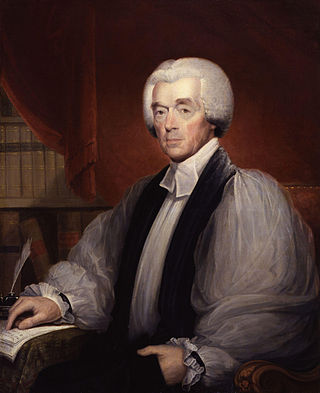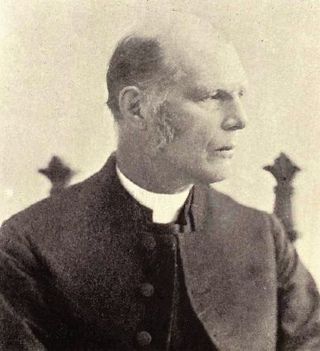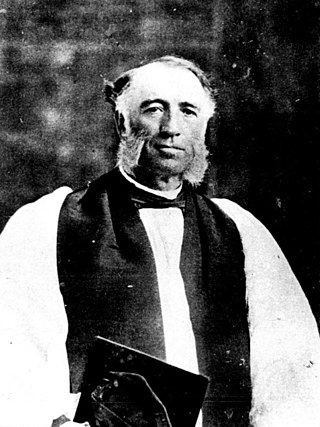
Charles Inglis was an Irish Anglican clergyman and ardent Tory who was consecrated the first Anglican bishop in North America for the Diocese of Nova Scotia. He died at Kingston, Nova Scotia. He is buried in the crypt of St. Paul's Church (Halifax).

The Anglican Church of Canada is the province of the Anglican Communion in Canada. The official French-language name is l'Église anglicane du Canada. In 2017, the Anglican Church counted 359,030 members on parish rolls in 2,206 congregations, organized into 1,571 parishes. The 2011 Canadian census counted 1,631,845 self-identified Anglicans, making the Anglican Church the third-largest Canadian church after the Catholic Church and the United Church of Canada. The 2021 Canadian census counted more than 1 million self-identified Anglicans, remaining the third-largest Canadian church.

The Cathedral of St. John the Baptist is located in the city of St. John's, Newfoundland and Labrador, Canada.
Howard Hewlett Clark was Primate of the Anglican Church of Canada from 1959 to 1971.
The Anglican Diocese of Eastern Newfoundland and Labrador is one of seven dioceses of the Ecclesiastical Province of Canada in the Anglican Church of Canada. As of 2012 the diocese had 50,000 members in 81 congregations organised in 35 parishes. The most widely spread parish has thirteen congregations.

The Diocese of Nova Scotia and Prince Edward Island is a diocese of the Ecclesiastical Province of Canada of the Anglican Church of Canada. It encompasses the provinces of Nova Scotia and Prince Edward Island and has two cathedrals: All Saints' in Halifax and St. Peter's in Charlottetown. Its de facto see city is Halifax, and its roughly 24 400 Anglicans distributed in 239 congregations are served by approximately 153 clergy and 330 lay readers according to the last available data. According to the 2001 census, 120,315 Nova Scotians identified themselves as Anglicans, while 6525 Prince Edward Islanders did the same.
The Diocese of Toronto is an administrative division of the Anglican Church of Canada covering the central part of southern Ontario. It was founded in 1839 and is the oldest of the seven dioceses comprising the Ecclesiastical Province of Ontario. It has the most members of any Anglican diocese in Canada. It is also one of the biggest Anglican dioceses in the Americas in terms of numbers of parishioners, clergy and parishes. As of 2018, the diocese has around 230 congregations and ministries in 183 parishes, with approximately 54,000 Anglicans identified on parish rolls.

The Diocese of Hamilton is a Latin Church ecclesiastical territory or diocese of the Catholic Church in Canada. It is a suffragan diocese in the ecclesiastical province of the metropolitan Archdiocese in Toronto.

Colin Robert Johnson is the former Anglican archbishop of Toronto and Moosonee, and he served as Metropolitan of the Ecclesiastical Province of Ontario from 2009 to 2018. He was the 11th Bishop of Toronto, the largest diocese in the Anglican Church of Canada.

Maurice Scollard Baldwin was a Canadian Anglican Bishop from Toronto, Upper Canada.

Arthur Sweatman (1834–1909) was a Canadian Anglican bishop and the third Primate of the Anglican Church of Canada.

The Anglican Diocese of Quebec was founded by Letters Patent in 1793 and is a part of the Ecclesiastical Province of Canada of the Anglican Church of Canada, in turn a province of the Anglican Communion. In 1842, her jurisdiction was described as "Canada East" or "Lower Canada". The diocese comprises 720,000 square kilometres and took its present shape in 1850 with the carving off of what is now the Diocese of Montreal. It includes a territory of west to east from Magog to the Gaspe and the Magdalen Islands, south to north from the United States border to Kawawachikamach and several communities along the Lower North Shore.
Derwyn Trevor Owen was the sixth Primate of the Anglican Church of Canada and the fifth Bishop of Niagara then Toronto.

The Anglican Diocese of Newfoundland was, from its creation in 1839 until 1879, the Diocese of Newfoundland and Bermuda, with the Cathedral of St. John the Baptist at St. John's, Newfoundland, and a chapel-of-ease named Trinity Church in the City of Hamilton in Pembroke Parish, Bermuda. Newfoundland and Bermuda had both been parts of British North America until left out of the 1867 Confederation of Canada. In 1842, her jurisdiction was described as "Newfoundland, the Bermudas". In 1879 the Church of England in the British Overseas Territory of Bermuda was created, but continued to be grouped with the Diocese of Newfoundland under the bishop of Newfoundland and Bermuda until 1919, when Newfoundland and Bermuda each received its own bishop.
Anthony John Burton is an Anglican bishop. He was formerly the Bishop of Saskatchewan in the Anglican Church of Canada. He was the rector of the Church of the Incarnation in Dallas, Texas, from 2008 to 2022. On February 13, 2022, Burton announced that he would retire as rector of the Church of the Incarnation in September 2022.

George Thorneloe was a Canadian Anglican bishop at the end of the 19th century and the beginning of the 20th.

Edward Sullivan was a Canadian Anglican priest.
William Lockridge Wright was a Canadian Anglican bishop in the 20th century.
Geoffrey Curtis Ralph Peddle was the bishop of the Diocese of Eastern Newfoundland and Labrador from 2014 to 2020.
St. Martin's Cathedral is a pro-cathedral of the Diocese of Central Newfoundland, a diocese of the Anglican Church of Canada, in Gander, Newfoundland and Labrador. St. Martin's was established as a parish church in 1959 and was elevated as a pro-cathedral after Gander became the episcopal see of the diocese after it, the Diocese of Western Newfoundland, and the Diocese of Eastern Newfoundland and Labrador were split from the former Diocese of Newfoundland in 1976. The current dean of the cathedral is David Hewitt. The cathedral hosts ordinations and the diocesan synods.